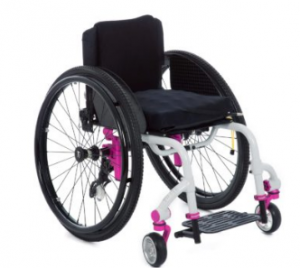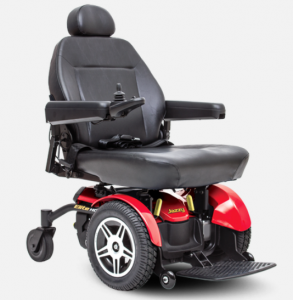

Deciding to order a power/motorized wheelchair or a manual chair is a highly individual decision. Some individuals use both if insurance will provide both options. Usually, motorized wheelchairs (power chairs) are needed for individuals who do not have good arm strength or control. They are powered by battery, not by pushing. Most individuals with SA/CRS have full arm/hand strength and control. They are usually fully capable of using a manual chair and find a manual chair supports good overall fitness and independence. They are powered by arm power, pushing the wheels. They can also be pushed by others, although that assistance should rarely be necessary.
Sometimes power chairs are recommended as a means for “keeping up with peers”. They move more easily on grassy surfaces such as playgrounds. They require no energy to go long distances. However, while they increase speed on grass, they usually can’t keep up with a peer who is running, either on grass or on a flat surface. Manual chairs, depending on the power of the push, can exceed the speed settings of power chairs on flat surfaces. While power chairs may seem at first glance to offer more “speed” and “ease”, they are restrictive in terms of access.
- They cannot ‘bump’ curbs (manual wheelchairs can).
- They cannot be transported without specialized and expensive vans and wheelchair lifts that most families cannot afford and that insurance does not cover.(manual wheelchairs can be taken apart easily to put into any car).
- They have to be recharged at a power supply
- They can’t be carried up a flight of stairs (manual wheelchairs can).
- They don’t fit into small, tight spaces (manual wheelchairs do).
- They don’t provide for natural fitness, important in the prevention of obesity or for the natural build-up of upper body strength that is important for independence. (manual chairs do).
- The repairs are complex, time consuming, and expensive (Often the teen or adult wheelchair user can independently repair issues that arise with a manual chair.)
Sometimes power wheelchairs are suggested as a means of preserving shoulder health however, a well fitting chair and a focus on maintaining the entire girdle of muscles around the shoulder usually supports good shoulder health. The power chair may promote obesity, a common concern for individuals with SA/CRS, and possibly a more serious health concern than shoulder health since obesity will also put great stress on the shoulders. Power chairs may be suggested to address complex seating issues, but these issues are often addressed with a manual chair using some of the suggestions in the chart here.
Some individuals find that a power chair is necessary or preferred. Those who are more active and athletic may maximize their potential in a manual chair while those who are less physical and active or who have limitations in arm strength may prefer a power chair. Those who need to travel over large distances and hilly terrain, perhaps on a college campus, may prefer a power chair (provided they have the ability to purchase a specialized van/lift equipment).
Because there are various pros and cons to manual versus power wheelchairs, one alternative that combines both is a portable power assist device that can easily attach and detach, converting a manual chair to a power chair. For keeping up with peers, some power ride on toys achieve the same goal at less cost. See “innovations” for ideas.
photo attribution: manual chair -Permobilus.com, Tilite
photo attribution: power chair-Pridemobility. com, Jazzy
